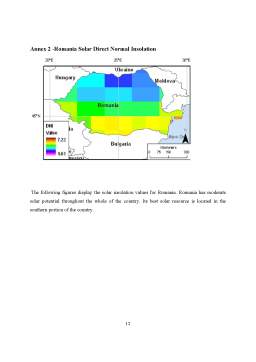Cuprins
- TABLE OF CONTENDS
- INTRODUCTION 4
- CHPATER 1 - OVERVIEW OF ELECTRICITY SUPPLY 5
- CHAPTER 2 – RENEWABLE SOURCES OF ENERGY IN ROMANIA 6
- CHAPTER 3 - HYDROELECTRIC ENERGY 8
- CONCLUSIONS 9
- BIBLIOGRAPHY 10
- ANNEX 1- ELECTRICITY MAP OF ROMANIA 11
- ANNEX 2 -ROMANIA SOLAR DIRECT NORMAL INSOLATION 12
- ANNEX 3 - GEOTHERMAL RESOURCE MAP 13
Extras din proiect
INTRODUCTION
Electricity demand in Romania declined during the 1990s, and several older thermal units were decommissioned. However, demand has recently increased and is expected to continue as the economy expands. Thus, many new electricity generation projects are underway. Privatization has proceeded slowly with many of the large industries still owned by the government. Plans have been made to privatize the electric sector; however, actual progress has been slow.
The most promising renewable energy resources appear to be wind, biomass, and hydro. Despite lower energy prices, Romania is considered a strong candidate for wind power development. There are well-documented wind resources, including a large off-shore potential. Total estimated mid term wind potential is 3,000 MW.
There are also good opportunities for biomass development, building off a very large base of existing capacity (over 4,000 MWth). Assuming an available biomass energy supply, district heating systems represent the most immediate and low-cost biomass application – especially CHP plants, industrial co-generation and co-firing.
In 1979 there was a wave of solar project development in the country, but due to poor quality equipment and inadequate installations, a deep dissatisfaction for solar projects resulted. Regardless, due to previous experience with solar and relatively high solar isolation, Romania may be open to solar project development.
The western region of Romania seems to be a good region for geothermal heat applications, although high enthalpy areas to support electric generation are limited. There are very good opportunities to develop small hydro projects in Romania. Over 2,600 MW of Romania’s electric capacity is generated from small hydro plants (100 MW or less).
CHPATER 1 - OVERVIEW OF ELECTRICITY SUPPLY
Electricity in Romania (see Annex 1) is primarily generated from thermal power plants (coal, natural gas, and oil), with the balance of production from hydroelectric facilities and a recently commissioned nuclear power plant.
The energy sector in Romania is supervised currently by the Ministry of Industry and Trade. The National Electricity Company, CONEL, is responsible for electricity transmission, and is also the system and market operator.
The whole economic and technical operation and development of the electricity sector is regulated, ruled, supervised and monitored by the National Electricity and Heat Regulatory Authority (ANRE), set up by an Emergency Ordinance in October 1998 as a public institution, independent and autonomous.
Although the government still owns a large portion of industrial assets, privatization of the energy sector has begun, and major upgrades to the energy sector are planned over the next ten years.
In the 2002 regular report on Romania's progress towards accession to the EU, the EU commission came to the conclusion that Romania does not devote the necessary resources to improving energy efficiency and promoting renewable energy
Table No. 1
Electricity disposition, billion kWh (2006) Figures
Generation 58.25
Consumption 48.43
Exports 3.36
Imports 1.28
Generation capacity, GW (2005)
Nuclear 0.71
Thermal 12.23
Hydro 6.28
Other renewable 0
Total 19.22
Sources: made by author based on CIA World Factbook, U.S. Energy Information Administration, United Nations Conference on Trade and Development
After years of delay, the government is moving quickly to privatize the state-owned power and gas assets in an effort to meet loan conditions set by the International Monetary Fund (IMF). In 2004, the government made substantial progress in fulfilling IMF loan conditions by selling stakes in regional gas and power distribution companies.
CHAPTER 2 – RENEWABLE SOURCES OF ENERGY IN ROMANIA
Wind. Romania currently has approximately 636 MW of wind capacity under construction. A majority of the capacity under construction is from the Fantanele and Cogeleac wind park, with 600 MW. The wind park is located in the southeastern region of Dobrogea, 17 km from the Black Sea. This park will account for approximately 30 percent of Romania’s renewable energy .
Biomass , Romania has great biomass potential, which is estimated at 88,000 GWh per year. In 2004, about 43 percent of the biomass potential in the country was exploited. The entirety of that biomass potential went to the production of heat. Heat generated from wood biomass was approximately 54 percent, and heat generated by agricultural biomass was about 46 percent.
Preview document
Conținut arhivă zip
- Romanian Renewable Energy Development.doc




















